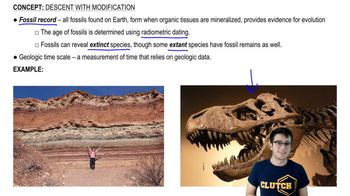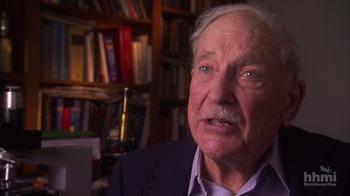Now, just because birds evolved from dinosaurs, doesn't mean that one day a dinosaur just gave birth to a bird. No. There were many transitional states along the way, and we call these transitional features. That's a trait that has a form somewhere between the ancestral one and that of the descendants. A great example of a transitional feature, transitional organism actually, is this, the archaeopteryx. This is kind of the missing link or one of those missing links between birds and dinosaurs. And you can see that the archaeopteryx was a type of dinosaur but it had this feather, it had these feathers and it was starting to gain that bird form. So this is just an example of a transitional feature. The dinosaur turning into the bird. Some organisms have what is called vestigial traits though and these are structures or attributes that have lost their ancestral functionality but still stick around. Great example of this are whales' back legs. Yeah, I bet you didn't know whales actually have the bones for back legs. Now, whales actually evolved from four-legged mammals. So, they lost the need for those back legs because their tails took over as their main mode of transit. But the bones for those back legs are still formed in whales and that is because they are vestigial trait. They're kind of an evolutionary hangover from where they came from, from their ancestors. Now, some traits, it's worth noting, are non-adaptive. Meaning, that these traits don't appear to be adaptive, and instead they have some sort of neutral or occasionally deleterious effect on fitness. So, basically, some evolved traits are not good for the organism necessarily. And this really gets at some of the main evolutionary misconceptions. First and foremost, it's very often that we throw around the word complexity. This organism is more complex than that organism. Humans are higher-order organisms than lowly bacteria. Guess what? Those aren't scientific terms. And in fact, those are really not scientific ideas. There's no definition for complexity. I mean, what really makes you more complex than bacteria? Scientifically, it's very hard to define. That term, complexity, is very vague term that gets thrown around. Additionally, this sort of higher order lower order hierarchy is also just kind of made up. There's no real scientific basis for any of those ideas. I mean, really what makes you so much higher order than bacteria? Those bacteria have been around for a heck of a lot longer than you have. And, you know, assuming something terrible were to happen to the Earth and humans were to die out, well, there'd probably be some bacteria that are still sticking around. Those are hardy, very resistant, little guys. So, in addition to that, it's important to know that evolution is constrained by genetic variation and what's already evolved. I, you know, if there isn't a lot of genetic variation in your population, then there won't be a lot of wiggle room for some traits to become more desirable than others if all the organisms are just all alike. Additionally, evolution is constrained by what's already evolved. Now what do I mean by that? I mean that every step that occurs in evolution is based on the previous step. So humans, for example, we could continue evolving and our form could continue to change, but it would have to be based on the form we have now. Right? We came from primates. Look at us, we still have a lot of the same kind of features that primates do because we can only modify what already exists. You can't create some completely new thing in evolution. It's always a modification of something that already existed. And lastly, evolution is not progressive. I mean, evolution will not continue to go along until it makes the perfect organism. There will never be the perfect organism. And that's because of fitness trade-offs. These are basically compromises between traits. So imagine, a chicken for example, and it evolves to produce more eggs. Yay, that's a good evolutionary advantage. Right? But guess what? There's a fitness trade-off because now that it's producing more eggs, it means that it has to make the shells of those eggs a little thinner. So even though it's making more eggs, those eggs are more fragile. That's a fitness trade-off. And that's the way things work in evolution. You make a little improvement on this thing and often it's at the detriment of this other thing. So, you can't create the perfect organism from evolution and no such thing as complexity or higher order and, of course, evolution is always just based on what came before it. So, that's the reality of evolution. That's all I have for this video. I'll see you guys next time.
Table of contents
- 1. Introduction to Biology2h 40m
- 2. Chemistry3h 40m
- 3. Water1h 26m
- 4. Biomolecules2h 23m
- 5. Cell Components2h 26m
- 6. The Membrane2h 31m
- 7. Energy and Metabolism2h 0m
- 8. Respiration2h 40m
- 9. Photosynthesis2h 49m
- 10. Cell Signaling59m
- 11. Cell Division2h 47m
- 12. Meiosis2h 0m
- 13. Mendelian Genetics4h 41m
- Introduction to Mendel's Experiments7m
- Genotype vs. Phenotype17m
- Punnett Squares13m
- Mendel's Experiments26m
- Mendel's Laws18m
- Monohybrid Crosses16m
- Test Crosses14m
- Dihybrid Crosses20m
- Punnett Square Probability26m
- Incomplete Dominance vs. Codominance20m
- Epistasis7m
- Non-Mendelian Genetics12m
- Pedigrees6m
- Autosomal Inheritance21m
- Sex-Linked Inheritance43m
- X-Inactivation9m
- 14. DNA Synthesis2h 27m
- 15. Gene Expression3h 20m
- 16. Regulation of Expression3h 31m
- Introduction to Regulation of Gene Expression13m
- Prokaryotic Gene Regulation via Operons27m
- The Lac Operon21m
- Glucose's Impact on Lac Operon25m
- The Trp Operon20m
- Review of the Lac Operon & Trp Operon11m
- Introduction to Eukaryotic Gene Regulation9m
- Eukaryotic Chromatin Modifications16m
- Eukaryotic Transcriptional Control22m
- Eukaryotic Post-Transcriptional Regulation28m
- Eukaryotic Post-Translational Regulation13m
- 17. Viruses37m
- 18. Biotechnology2h 58m
- 19. Genomics17m
- 20. Development1h 5m
- 21. Evolution3h 1m
- 22. Evolution of Populations3h 52m
- 23. Speciation1h 37m
- 24. History of Life on Earth2h 6m
- 25. Phylogeny2h 31m
- 26. Prokaryotes4h 59m
- 27. Protists1h 12m
- 28. Plants1h 22m
- 29. Fungi36m
- 30. Overview of Animals34m
- 31. Invertebrates1h 2m
- 32. Vertebrates50m
- 33. Plant Anatomy1h 3m
- 34. Vascular Plant Transport2m
- 35. Soil37m
- 36. Plant Reproduction47m
- 37. Plant Sensation and Response1h 9m
- 38. Animal Form and Function1h 19m
- 39. Digestive System10m
- 40. Circulatory System1h 57m
- 41. Immune System1h 12m
- 42. Osmoregulation and Excretion50m
- 43. Endocrine System4m
- 44. Animal Reproduction2m
- 45. Nervous System55m
- 46. Sensory Systems46m
- 47. Muscle Systems23m
- 48. Ecology3h 11m
- Introduction to Ecology20m
- Biogeography14m
- Earth's Climate Patterns50m
- Introduction to Terrestrial Biomes10m
- Terrestrial Biomes: Near Equator13m
- Terrestrial Biomes: Temperate Regions10m
- Terrestrial Biomes: Northern Regions15m
- Introduction to Aquatic Biomes27m
- Freshwater Aquatic Biomes14m
- Marine Aquatic Biomes13m
- 49. Animal Behavior28m
- 50. Population Ecology3h 41m
- Introduction to Population Ecology28m
- Population Sampling Methods23m
- Life History12m
- Population Demography17m
- Factors Limiting Population Growth14m
- Introduction to Population Growth Models22m
- Linear Population Growth6m
- Exponential Population Growth29m
- Logistic Population Growth32m
- r/K Selection10m
- The Human Population22m
- 51. Community Ecology2h 46m
- Introduction to Community Ecology2m
- Introduction to Community Interactions9m
- Community Interactions: Competition (-/-)38m
- Community Interactions: Exploitation (+/-)23m
- Community Interactions: Mutualism (+/+) & Commensalism (+/0)9m
- Community Structure35m
- Community Dynamics26m
- Geographic Impact on Communities21m
- 52. Ecosystems2h 36m
- 53. Conservation Biology24m
21. Evolution
Introduction to Evolution and Natural Selection
Video duration:
5mPlay a video:
Related Videos
Related Practice































